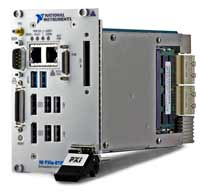PXI Controller
PXI controller, details of its operation, functions and the various options for controlling a PXI chassis.
PXI tutorial includes:
What is PXI?
PXI standard
PXI chassis
PXI bus and backplane
PXI controller
PXI cards & modules
PXI software
PXI Express
PXImc MultiComputing
Set-up & build PXI system
A PXI system is controlled by what is termed the system controller.Often this controller is a card that is located within the PXI chassis, making the overall chassis self-contained and able to operate without any external controller.
The PXI controller is able to provide all the control needed to operate the PXI system.

PXI controller basics
Most PXI chassis contain a slot for an internal system controller. This must be located in slot 1, the left most slot of the chassis. However, there are several options for a PXI controller:
Embedded PXI controller: The advantage of an embedded controller is that it removes the requirement for an external PC or laptop which adds to the space taken by the overall system.
Embedded controllers are complete with all the components necessary for a computer including the main CPU, RAM, hard disc drive, and all the relevant peripherals. They typically run Windows software and have all device drivers installed.
In this way, the PXI controller is a complete computer contained within a PXI module. It can enable the whole PXI system to be contained within one box, making it ideal for portable operation, or operation in a remote site where external computers, etc. may not be applicable.
Laptop controller: For many applications, a laptop style PC is an ideal option. Having the integrated display, keyboard and other elements of the computer within the laptop package, it provides additional power and convenience for some applications. Typically a laptop controller option will require a PCMCIA interface to allow connection to the laptop.
The advantage of a laptop controller is that it gives more flexibility of operation to enable changes updates and for general operator interaction. While keyboards and displays, etc can be added to the embedded controller, the aim is that it will be a system in one box, and under these circumstances a laptop used as the controller may offer a better solution.
PC controller: The PC based controller for a PXI test system is often the best option for a laboratory. It has the capability to provide the highest level of control and performance.
In this configuration the control of the PXI system is run from PC through a software and driver-transparent link. During boot-up, the computer recognises all peripheral modules in the PXI system as PCI boards. When operating in this mode, the PXI cards are recognised as PCI cards and can be controlled in the normal way for PXI.
To provide PC control of a PXI system, a PCI/PCI Express board is required in the computer and a PXI/PXI Express module is needed in slot 1 of the PXI system. This can be connected via a traditional copper cable or where very high speeds or high data levels are needed a fibre optic cable could be used.
The choice of the type of PXI controller will very much depend upon the application for which the system is intended. PXI has sufficient flexibility to enable it to be configured for internal embedded controllers, laptops and desktop PCs. Software can even be transferred, possibly being developed on a desktop system and the used with a laptop or embedded PXI controller.
 Written by Ian Poole .
Written by Ian Poole .
Experienced electronics engineer and author.
More Test Topics:
Data network analyzer
Digital Multimeter
Frequency counter
Oscilloscope
Signal generators
Spectrum analyzer
LCR meter
Dip meter, GDO
Logic analyzer
RF power meter
RF signal generator
Logic probe
PAT testing & testers
Time domain reflectometer
Vector network analyzer
PXI
GPIB
Boundary scan / JTAG
Data acquisition
Return to Test menu . . .


